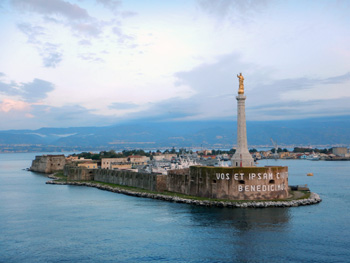
by Darlene Foster
We enter the harbour of Messina, greeted by a golden lady perched on top of a very tall column. Inscribed at the base are the words – “Vos et ipsam cictatem benedicimus”. This sparks my curiosity and I’m determined to learn more about this edifice guarding the port. The heavy rain does not deter me as I leave the boat to explore. I am excited to be in Sicily for the first time.
It has been my experience that a stop at a cathedral is always a good place to start. One can learn much about a city from its cathedrals and churches. It is also a good way to get of the rain. As I approach the Duomo de Capanile, I am intrigued by the massive bronze front door embossed with biblical scenes. My breath is taken away when I enter the vast central nave lined with marble pillars and archways. Inside the alcoves are life sized marble statues of the disciples and apostles. In an elaborate setting at the end of the nave is an image of the Madonna of the Letter, the patron saint of the city. A thick silver overlay, with the faces of the Madonna and child cut out, covers the painting.
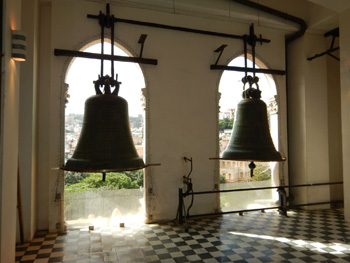 I visit the gift shop to buy postcards and ask questions. The friendly shop keeper is happy to oblige a curious Canadian. She explains that the words under the Madonna at the entrance of the port translate into – “We bless you and the city.” It is believed that this message had been written in a letter to the people of Messina by the Virgin Mary when they converted to Christianity in 42 AD, after a visit from the apostle Paul. This explains why she is called Madonna della Lettera or Madonna of the Letter. I purchase a ticket for five euros to visit the museum and attached clock tower.
I visit the gift shop to buy postcards and ask questions. The friendly shop keeper is happy to oblige a curious Canadian. She explains that the words under the Madonna at the entrance of the port translate into – “We bless you and the city.” It is believed that this message had been written in a letter to the people of Messina by the Virgin Mary when they converted to Christianity in 42 AD, after a visit from the apostle Paul. This explains why she is called Madonna della Lettera or Madonna of the Letter. I purchase a ticket for five euros to visit the museum and attached clock tower.
The museum is small, with a few interesting pieces including an impressive golden manta created in 1668. It is similar to the silver covering on the image in the nave with the faces cut out, except in gold and decorated with many jewels. I return to the gift shop with more questions. The accommodating shop keeper explains that on special occasions, the silver covering, is replaced with the one in gold. It is common to cover sacred images with silver or gold robes, leaving only the faces uncovered. Fascinating.
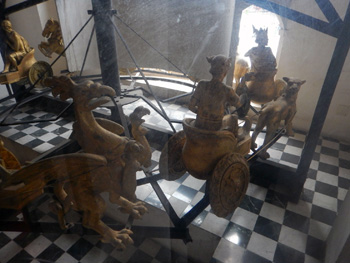 I venture next door to climb the 236 steps to the top of the bell tower. It is worth every step. This belfry houses the largest and most complex mechanical and astronomical clock in the world. On the landings I am able to view, from the inside, the amazing mechanically animated bronze images that rotate on the façade of the tower at the stroke of noon. At the top levels hang the massive bells that ring out the time. I am fortunate I timed my visit between the ringing of the bells. Once at the top, I am rewarded with a splendid view of the city from all four directions. The rain has stopped and the sun is out in full force. I feel I am in heaven, or close to it. I take my time descending, in order to have a better look at the intricate figures, aided by explanations on boards in English as well as Italian. The carousel of life, composed of four golden life size figures representing childhood, youth, maturity and old age, has death in the form of a skeleton following behind. Biblical scenes are depicted on other carousels and changed according to the liturgical calendar. One scene is dedicated to the Madonna of the Letter, where an angel brings the letter to the Virgin Mary followed by St. Paul and the ambassadors who bow when passing in front of the virgin.
I venture next door to climb the 236 steps to the top of the bell tower. It is worth every step. This belfry houses the largest and most complex mechanical and astronomical clock in the world. On the landings I am able to view, from the inside, the amazing mechanically animated bronze images that rotate on the façade of the tower at the stroke of noon. At the top levels hang the massive bells that ring out the time. I am fortunate I timed my visit between the ringing of the bells. Once at the top, I am rewarded with a splendid view of the city from all four directions. The rain has stopped and the sun is out in full force. I feel I am in heaven, or close to it. I take my time descending, in order to have a better look at the intricate figures, aided by explanations on boards in English as well as Italian. The carousel of life, composed of four golden life size figures representing childhood, youth, maturity and old age, has death in the form of a skeleton following behind. Biblical scenes are depicted on other carousels and changed according to the liturgical calendar. One scene is dedicated to the Madonna of the Letter, where an angel brings the letter to the Virgin Mary followed by St. Paul and the ambassadors who bow when passing in front of the virgin.
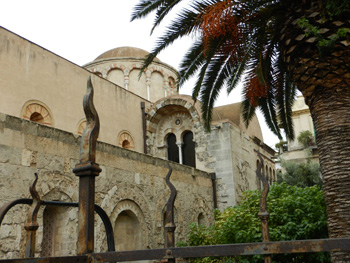 The vibrant plaza in front of the cathedral holds the gorgeous Fountain of Orion. A great place to view the clock tower from the outside and watch it come to life, should you be there at noon. I remove my raincoat and wander the streets. I find an iron worker creating figures in front of his shop called Hollywood. Many sculptures are scattered throughout the town including an imposing conquistador. The picturesque Church of the Catalans, built before Norman times on a pagan site dedicated to the god Neptune, provides different views from each side. A quote from Shakespeare catches my eye, “I learn in this letter that Don Pedro of Arragon comes this night to Messina… He hath an uncle in Messina will be much glad of it.” from Much Ado About Nothing.
The vibrant plaza in front of the cathedral holds the gorgeous Fountain of Orion. A great place to view the clock tower from the outside and watch it come to life, should you be there at noon. I remove my raincoat and wander the streets. I find an iron worker creating figures in front of his shop called Hollywood. Many sculptures are scattered throughout the town including an imposing conquistador. The picturesque Church of the Catalans, built before Norman times on a pagan site dedicated to the god Neptune, provides different views from each side. A quote from Shakespeare catches my eye, “I learn in this letter that Don Pedro of Arragon comes this night to Messina… He hath an uncle in Messina will be much glad of it.” from Much Ado About Nothing.
I stumble upon an overgrown archaeological dig behind a municipal building. I have the place to myself and imagine what it was like when Messina was a smaller Roman town. Signs, explaining the dig and what was discovered, are in Italian but I get the idea.
 Messina has always been the main portal to Sicily. Founded by the Greeks in the eighth century BC, the influence of Romans, Byzantines, Arabs, Normans and Swabians, who have landed on these shores over the years, contributes to the rich culture.
Messina has always been the main portal to Sicily. Founded by the Greeks in the eighth century BC, the influence of Romans, Byzantines, Arabs, Normans and Swabians, who have landed on these shores over the years, contributes to the rich culture.
The city has been subject to many earthquakes over the centuries and I find it amazing that so much history has been left intact. One young shop keeper tells me there aren’t many old things in her city as so much has had to be rebuilt or restored due to damages from earthquakes. The last major earthquake was in 1908. The city also suffered much damage during World War II. They have done an impressive job of keeping the flavour of this city alive.
I purchase a bag of Italian pasta, a great reminder of my enjoyable time in this amazing Sicilian city. As the ship leaves port, I wave goodbye to Our Lady of the Letter with her comforting message sent to the citizens two thousand years ago.
If You Go:
♦ You can get to Messina on a short ferry ride across the Straits of Messina by car, train or bus from one of two ports in Calabria, or on a longer ferry ride from Salerno, just south of Naples. – See more at: www.reidsitaly.com.
♦ Some cruise ships stop at Messina or you can arrive by your own yacht.
♦ Messina is easy to walk around, but there are bus, train, and horse and buggy tours available from the plaza in front of the cathedral for 10 to 20 euros.
♦ Arranging your visit around noon would enable you to see the clock tower come to life.
♦ To climb the clock tower a ticket for 5 euros is required which includes entrance to the museum in the cathedral. This can be purchased in the gift shop of the cathedral
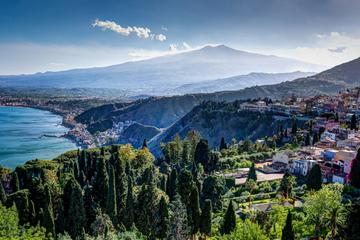
Best Sicilian Offer: Private Tour of Etna – Alcantara – Godfather – Food and Wine from Messina
About the author:
Darlene Foster is a dedicated writer and traveler. She is the author of a series of books featuring Amanda, a spunky young girl who loves to travel to interesting places such as the United Arab Emirates, Spain, England and Alberta, where she always has an adventure. Darlene divides her time between the west coast of Canada and the Costa Blanca of Spain. www.darlenefoster.ca
All photos are by Darlene Foster:
Madonna of the Letter
Clock Tower Bells
Carousel of Life
Church of the Catalans
The Church and Tower




Leave a Reply
You must be logged in to post a comment.